Stepping into the wild side of New South Wales unveils a variety of animals, each with its unique traits. While many are harmless or shy away from humans, there are a few that pose a danger due to their venom, size, or behavior. This article will explore the world of New South Wales’ deadliest animals.
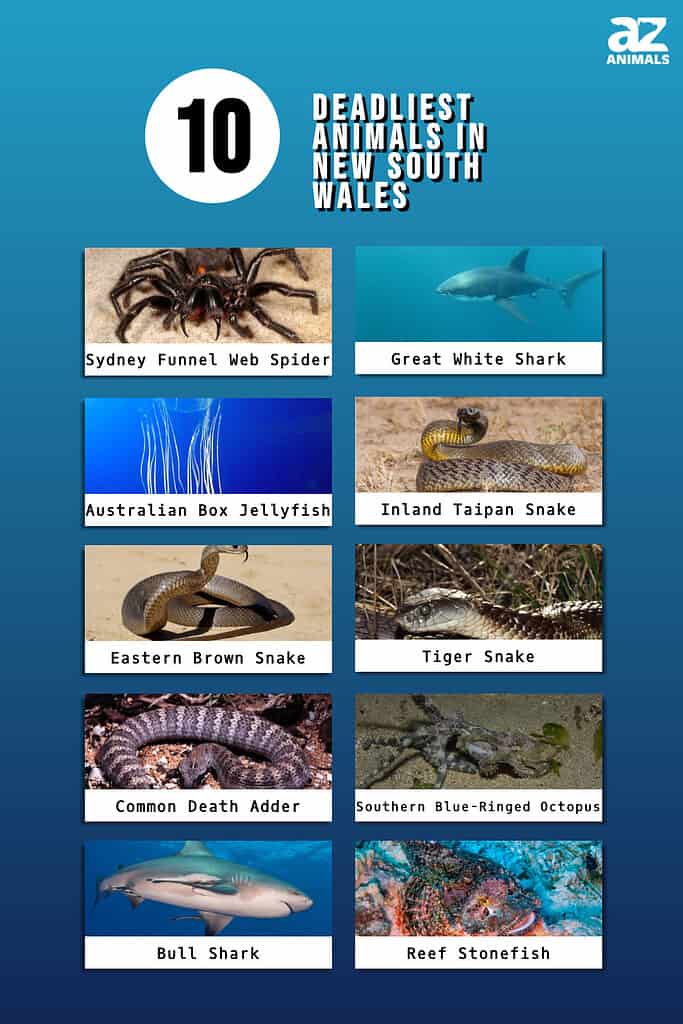
From stealthy snakes to powerful marine creatures, we’ll uncover the top menacing animals that call this region home. Each has its own story of survival, displaying nature’s raw yet fascinating side. So, brace yourself as we explore the list of the deadliest inhabitants in New South Wales! Let’s get into it!
1. Sydney Funnel-Web Spider (Atrax robustus)
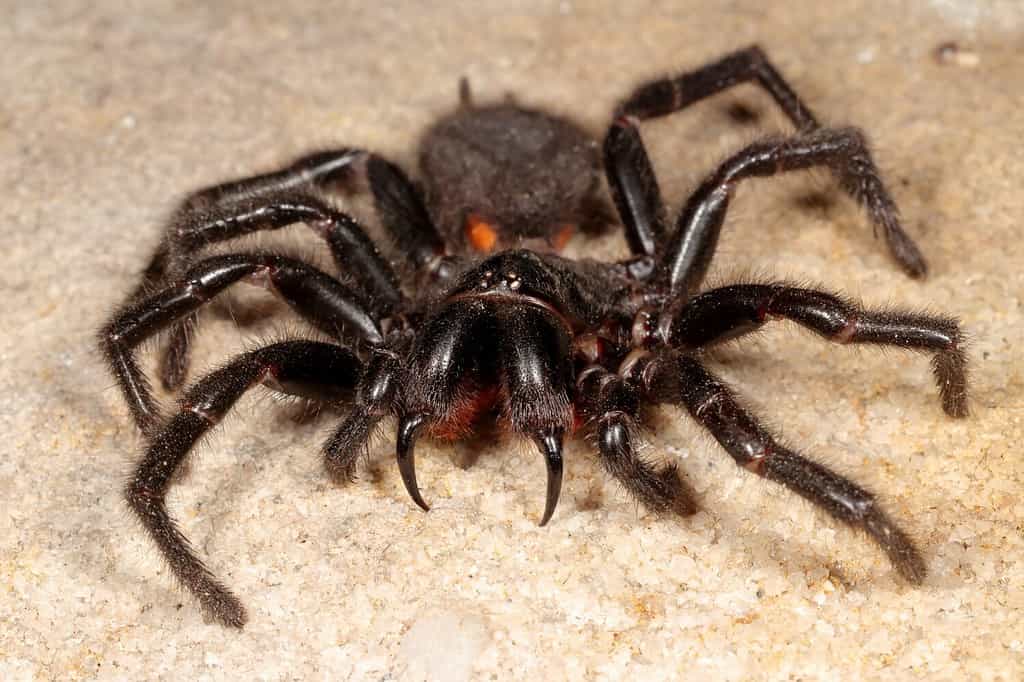
Number one on this list of the deadliest animals in New South Wales is the Sydney funnel-web spider.
©Ken Griffiths/Shutterstock.com
First up is the Sydney funnel-web spider, which holds the title of the deadliest spider in Australia and in the world. A bite from this spider can be fatal within just 15 minutes. You’ll find these spiders mainly in New South Wales, spanning areas from Newcastle to Nowra and as far west as Lithgow.
These spiders have a glossy, dark brown or black appearance and feature appendages for spinning silk at the end of their bodies. The males are easily identified by a prominent mating spur on their second pair of legs. These spiders vary in size, with their bodies measuring anywhere from 0.4 to 2 inches long.
They make their homes in damp, cool hideouts under rocks and logs, setting up silk threads to act as alarms for incoming prey. Their meals mainly consist of insects, although they’re known to eat larger creatures like frogs and lizards as well.
While not naturally aggressive, the Sydney funnel-web spider will become hostile if it feels threatened.
How Deadly Is the Sydney Funnel Web Spider?
Though this spider is one of the world’s most poisonous, causing 13 recorded deaths, an effective antivenom was created in 1981. Since its introduction, no deaths have been recorded, and it has saved over 100 lives.
Getting bitten by a male funnel-web spider is extremely dangerous; without immediate treatment, survival is unlikely. The fatality rate for untreated bites from these spiders is 100%.
2. Great White Shark (Carcharodon carcharias)
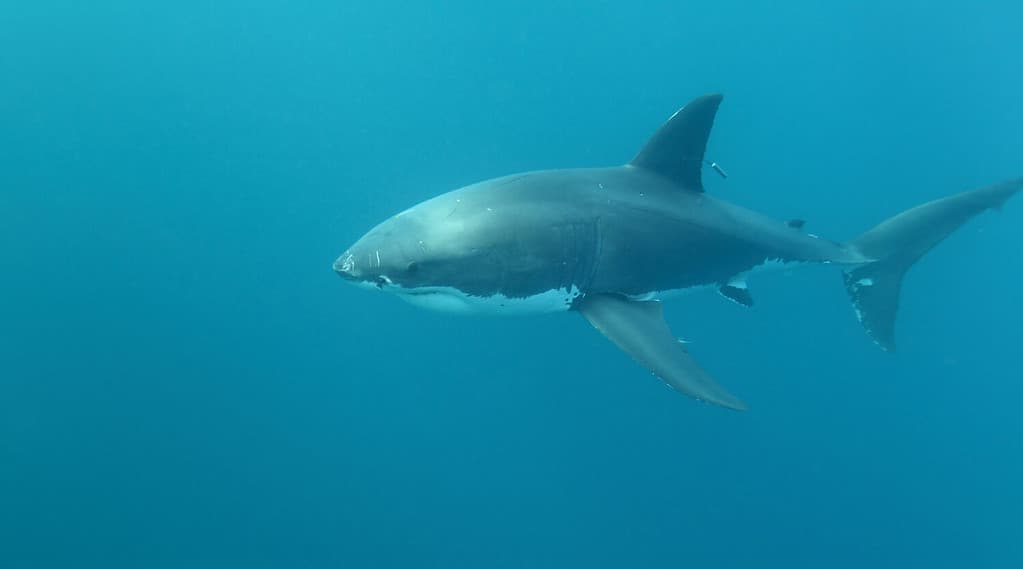
Of course, one of the deadliest ocean animals in New South Wales is none other than the great white.
©Alessandro De Maddalena/Shutterstock.com
Moving on to the ocean’s depths, let’s talk about the feared great white shark, often found in the chillier coastal regions, including New South Wales.
You can identify these sharks by their unique coloration: a white belly contrasted by a back that varies from brown to gray. This helps them camouflage in the water. These awe-inspiring predators can measure up to an impressive 21 feet.
Although these deadly fish are closely associated with places like Australia and South Africa, you’ll find them in coastal waters worldwide. Their meals vary widely, encompassing small ocean creatures, sea birds, and even larger marine mammals like seals and dolphins.
How Deadly Is the Great White Shark?
These sharks have earned their reputation for aggression, standing virtually unrivaled at the pinnacle of marine predators.
They’re notorious for having the highest number of human attacks among all sharks, with about 350 incidents in the past two centuries. Out of them, more than 50 were deadly, according to global records.
After 2021, 14 shark-related injuries were documented in New South Wales, with three resulting in death—all were the work of great white sharks.
3. Australian Box Jellyfish (Chironex fleckeri)

Another dangerous animal in New South Wales is the box jellyfish.
©Avispa marina.jpg: Guido Gautsch, Toyota, Japanderivative work: Mithril, CC BY-SA 2.0 – License
Next on our list of New South Wales’ deadliest animals is the occasional visitor, the box jellyfish.
Also known as marine stingers or sea wasps, these jellyfish mainly visit waters in Northern Australia and other parts of the Indo-Pacific. However, they have been spotted in northern New South Wales. They’re transparent with a pale blue color, making them difficult to see. Their distinct feature is a bell-shaped body from which up to 60 tentacles can hang in clusters. Notably, these tentacles can sting even after the creature is dead or separated from the body.
The bell can be as wide as 11 inches, and its tentacles can stretch to an impressive 10 feet.
You’re likely to encounter them in various coastal settings like mangrove areas, coral ecosystems, kelp-rich waters, and even sandy beaches. These predators feast on various smaller marine life, including fish and other jellyfish. Surprisingly, they can swim relatively quickly, clocking in at speeds up to 4.6 mph
While they typically avoid human interaction, they will sting if they feel cornered or threatened.
How Deadly Is the Australian Box Jellyfish?
They’re infamous for being among the ocean’s most toxic creatures. The venom in their tentacles can cause a range of severe health complications, such as paralysis and heart failure, and can be deadly in a matter of minutes.
Since record-keeping began, 79 people have died from stings by these jellyfish in Australia.
Given the lethal potential, it’s wise to exercise extreme care around these nearly invisible but highly dangerous marine animals.
4. Inland Taipan Snake (Oxyuranus microlepidotus)

The inland taipan snake is incredibly dangerous!
©Ken Griffiths/Shutterstock.com
Moving to the far west corner of New South Wales, we find the inland taipan.
Its color varies with the seasons, transitioning from a deep, dark tan to a lighter greenish-brown. The snake’s back, sides, and tail can display various shades of brown and gray, often bordered by darker, almost black edges on the scales.
On average, this snake measures around 6.5 feet, although some can grow as long as 8.8 feet.
These snakes are typically found in areas with black soil, floodplains, and flat rocky areas. Their diet consists exclusively of mammals, most commonly native rats. They usually corner their prey in burrows or soil crevices before delivering multiple quick bites.
Despite its deadly potential, it’s relatively elusive and not naturally aggressive, but caution is absolutely crucial in areas where it’s known to live.
How Deadly Is the Inland Taipan Snake?
The inland taipan is the world’s most venomous snake and is a formidable predator in Australia’s rugged outback.
What sets this snake apart is its extraordinarily toxic venom. The highest recorded venom yield from a single bite is 110mg, enough to kill more than 100 humans or a staggering 250,000 mice. Despite its fearsome reputation, the inland taipan remains relatively unknown outside Australia.
5. Eastern Brown Snake (Pseudonaja textilis)
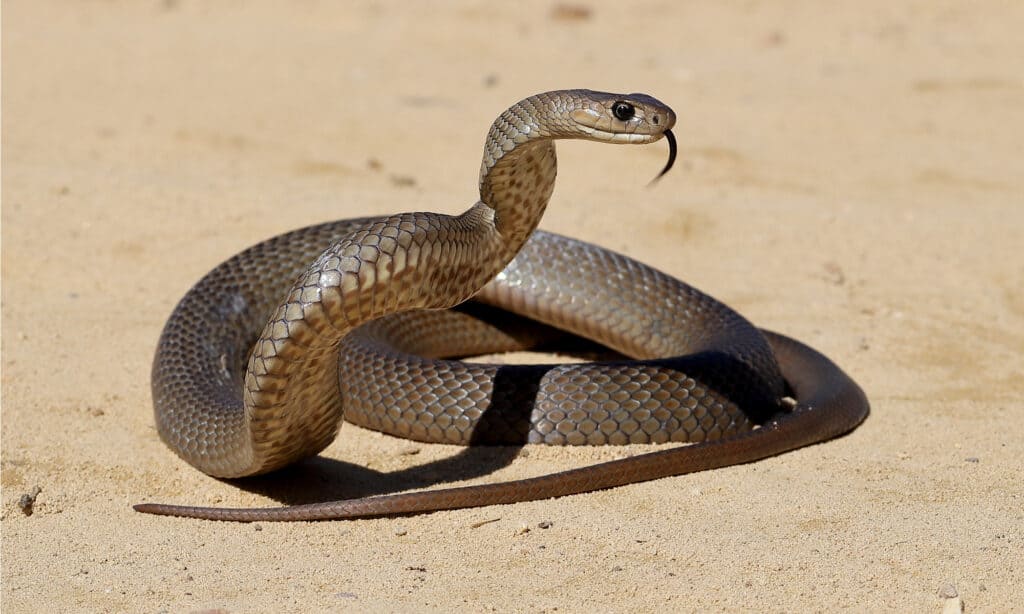
Another highly venomous snake in New South Wales is the eastern brown snake.
©Ken Griffiths/Shutterstock.com
The fifth deadliest animal on this list is the eastern brown snake, often spotted most frequently during the spring season in central southern New South Wales.
This snake is lean and long, with a color that varies from light to dark brown on its upper side. Its belly is usually a mix of cream, yellow, or gray and sometimes features orange spots or darker patterns near the tail.
While the average size is around 4.9 feet, some can stretch to an imposing 7.8 feet, with males typically growing larger than females.
These snakes favor wide-open spaces such as woodlands, scrubby areas, and grassy plains. In drier regions, they stick to places that experience some level of seasonal flooding, like marshes and riverbanks. Their diet mainly consists of rodents but also includes smaller reptiles and amphibians.
How Deadly Is the Eastern Brown Snake?
Notorious for their speed and aggressive nature, eastern brown snakes account for more fatalities in Australia each year than any other snake species. Their venom is second in toxicity only to Australia’s inland taipan. It’s a potent mix of toxins, and its bite leads to one or two deaths annually on average.
Given their lethal venom and quick-to-strike demeanor, caution is highly advised when in areas where these snakes are known to live.
6. Tiger Snake (Notechis scutatus)

Found near water bodies,
tiger
snakes are dangerous creatures.
©SunofErat_Matt_CCBY2.0 – License
Tiger snakes are found along the southeast coastline of Australia, specifically in areas like eastern and southern New South Wales.
These snakes are robust and generally measure between 3 and 5 feet in length. They have a somewhat broader head that sets it apart from the neck. While many have alternating dark brown and yellowish-brown stripes, some don’t display this patterning. The snake’s belly is usually a lighter shade and lacks bands.
Tiger snakes are commonly found near water bodies like streams, rivers, and marshlands. Frogs make up the bulk of their diet, but they also eat other reptiles, small mammals, birds, and fish.
When threatened, tiger snakes adopt a posture that can seem aggressive. They flatten their heads and necks and rear up, much like a cobra, to intimidate whoever is confronting them. However, they usually won’t bite unless further provoked.
How Deadly Is the Tiger Snake?
Tiger snake venom is extremely dangerous, containing a mix of blood-clotting agents, neurotoxins, and muscle-damaging substances. These snakes are responsible for about 17% of all snakebite incidents in Australia.
The venom is produced in significant amounts, averaging around 35 to 65 milligrams per bite. The highest recorded amount was 180 milligrams. The consequences of a bite can include paralysis, blood clotting issues, muscle deterioration, and, in severe cases, kidney failure and death.
7. Common Death Adder (Acanthophis antarcticus)
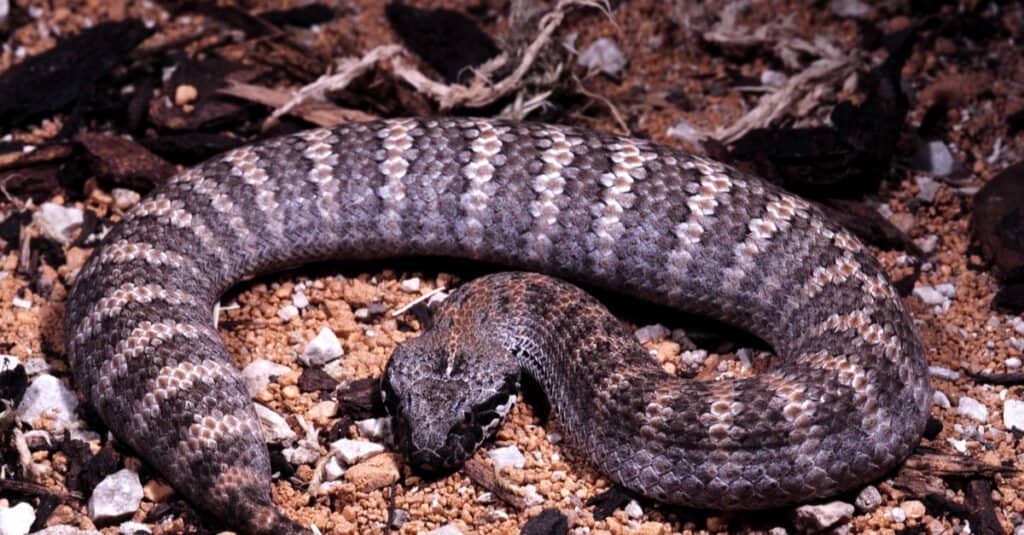
Another snake you should keep an eye out for is the common death adder.
©Vladislav T. Jirousek/Shutterstock.com
The common death adder ranks as one of New South Wales’ most dangerous and deadliest snakes.
With a broad, flat, triangular head and a stout body adorned with bands of black, red, and brown, it’s a snake you wouldn’t want to encounter. The pale-colored belly could be gray, cream, or pink. Fully grown, this snake can measure between 2.3 and 3.3 feet and boasts the longest fangs of any snake in Australia.
The snake is highly adaptable, thriving in various landscapes such as woodlands, open fields, and shrubby zones. Adult death adders prefer to eat small mammals, birds, and smaller reptiles like geckos and lizards, while the young feed on tiny reptiles and frogs.
Although not typically aggressive, their ability to hide in plain sight can lead to unintentional human contact and subsequent bites.
How Deadly Is the Common Death Adder?
The venom of the death adder is notably potent, containing a neurotoxin that can be lethal to humans within six hours.
The snake’s venom can vary in quantity, averaging about 85 milligrams, but can be as high as 235 milligrams. It mainly attacks the nervous system without significantly affecting blood coagulation or muscle tissue.
Before the availability of antivenom, about half of the people who were bitten by this snake lost their lives.
8. Southern Blue-Ringed Octopus (Hapalochlaena maculosa)
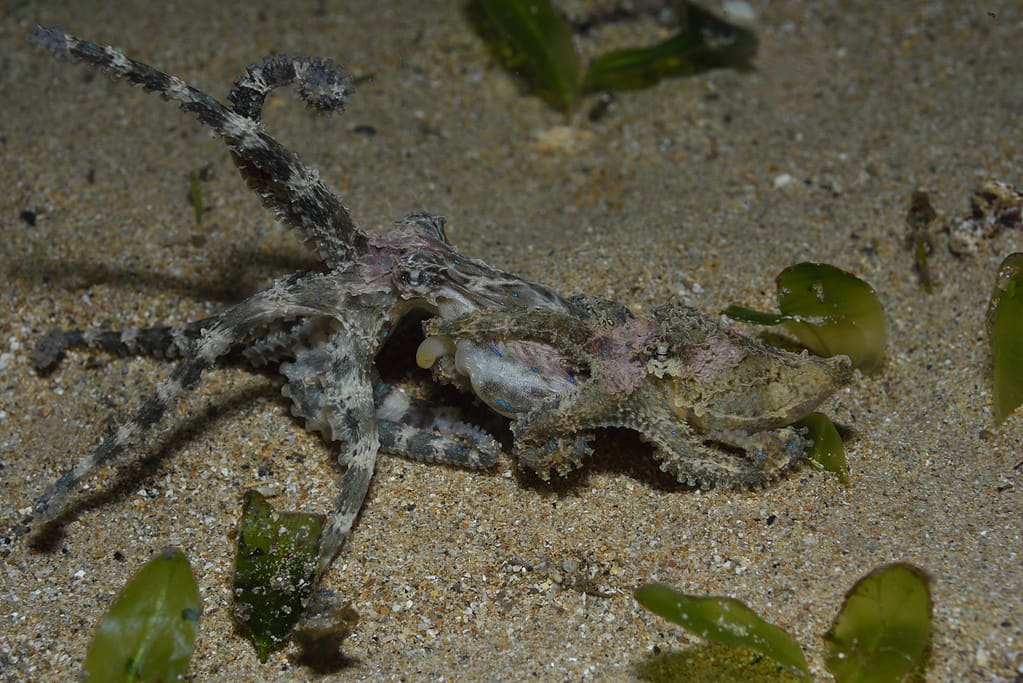
While southern blue-ringed octopuses are generally brown, they will reveal blue rings when threatened or seeking prey.
©Nigel Marsh/iStock via Getty Images
Also called the southern blue-lined octopus, the southern blue-ringed octopus is a creature to be cautious of, especially along the coasts from Southern Queensland down to New South Wales.
Typically brown, the octopus reveals striking blue rings when threatened or seeking prey. Usually, it doesn’t grow beyond 8 inches in length.
This octopus prefers the shallows, often residing in areas with rocky reefs or seagrass beds. It’s a carnivore with a preference for crabs and other tiny shellfish.
Although not inclined to attack, it shouldn’t be underestimated. Its blue rings act as a natural signal to ward off predators and alert humans who might get too close.
How Deadly Is the Southern Blue-Ringed Octopus?
The venom this octopus carries is extremely lethal, with as little as 1 milligram capable of killing a human. The worst part? There’s no antidote available. The toxicity of its venom surpasses that of cyanide by a factor of a thousand. Despite its small size — comparable to a golf ball, it has enough venom to end 26 human lives in just a few minutes.
Due to its deadly nature, it’s ranked among the ocean’s most deadliest animals.
9. Bull Shark (Carcharhinus leucas)
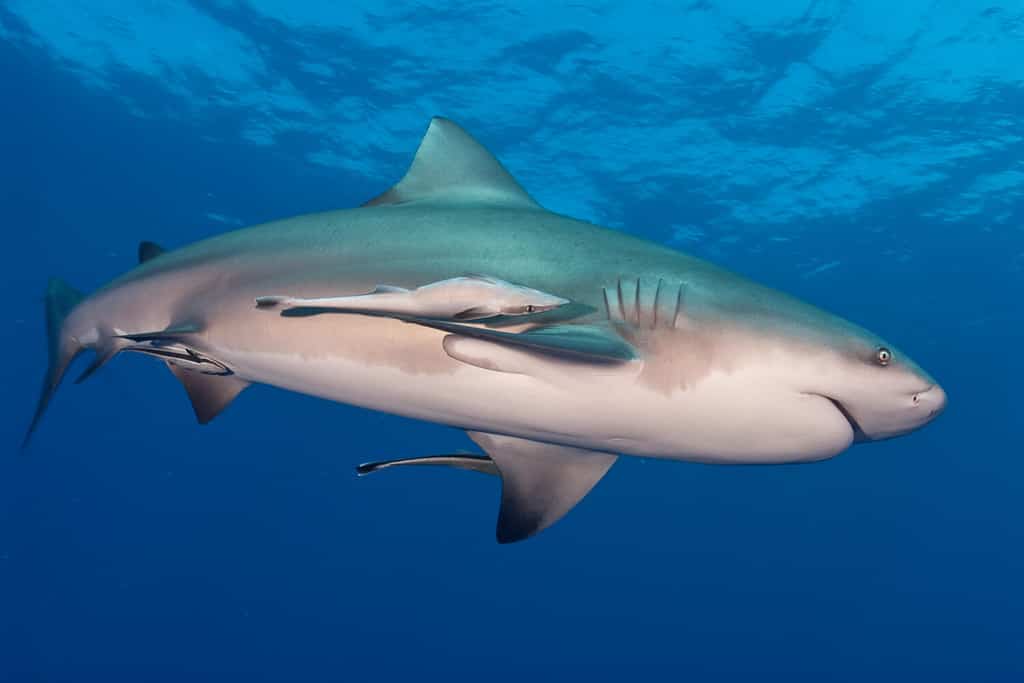
Another one of the deadliest animals to look out for in New South Wales is the bull shark.
©Fiona Ayerst/Shutterstock.com
Bull sharks frequently visit the Great Barrier Reef in winter and spring, then head toward Sydney Harbor and nearby New South Wales rivers during the summer months.
Typically, they grow between 7 and 11.5 feet long. Their dorsal skin is usually a shade of gray that lightens to white on their belly, and their snouts are short and broad.
Unlike other sharks, bull sharks can adapt to various water conditions, from salty ocean waters to brackish and even freshwater settings. They are the only shark species with the ability to live in freshwater for long periods.
Their diet includes fish, other sharks, sea creatures like dolphins and turtles, birds, stingrays, and even land animals such as cattle and dogs.
These sharks have gained a reputation as some of the most aggressive sharks in the world!
How Deadly Is the Bull Shark?
What adds to their risk factor is their preference for warm, shallow coastal areas, which are often populated by humans.
With a bite force averaging up to 1,350 pounds per square inch, bull sharks have one of the strongest bites among animals. Usually, if they do bite a human, it’s a single curious bite. However, given their large size, even one bite can be lethal or cause serious injury.
10. Reef Stonefish (Synanceia verrucosa)

Reef stonefish are camouflaged and incredibly dangerous.
©Alberto Carrera/iStock / Getty Images Plus via Getty Images
In Australia, reef stonefish are commonly found stretching from the Great Barrier Reef in Queensland down to the northernmost parts of New South Wales.
These fish are experts at blending in with their surroundings, resembling lumpy coral or rocks. Their color varies from brown or gray with occasional spots of yellow, orange, or red. They usually grow up to 13 inches, although some can reach 20 inches. Their dorsal fins feature 13 thick spines.
Stonefish often hide in shallow pools and reef flats with either sandy or rubble-covered bottoms. They’re ambush predators, lying in wait for fish and crustaceans to pass by before attacking at lightning speed.
While not inherently aggressive, encounters with stonefish usually happen by accident.
How Deadly Is the Stonefish?
Reef stonefish hold the title of the world’s most venomous fish. Their venom, released through 13 dorsal spines when pressure is applied, affects both the heart and nervous system. If you accidentally step on one, the fish’s spines eject venom from two small pouches at their base.
The venom causes extreme pain and has been fatal to people living on islands in the Pacific and Indian Oceans. Since the introduction of an antivenom in 1959, the chances of dying from a stonefish sting have decreased. However, numerous individuals still experience the severe pain of being stung each year.
Summary of the Deadliest Animals in New South Wales
| Rank | Animal | Scientific Name |
|---|---|---|
| 1. | Sydney Funnel Web Spider | Atrax robustus |
| 2. | Great White Shark | Carcharodon carcharias |
| 3. | Australian Box Jellyfish | Chironex fleckeri |
| 4. | Inland Taipan Snake | Oxyuranus microlepidotus |
| 5. | Eastern Brown Snake | Pseudonaja textilis |
| 6. | Tiger Snake | Notechis scutatus |
| 7. | Common Death Adder | Acanthophis antarcticus |
| 8. | Southern Blue-Ringed Octopus | Hapalochlaena maculosa |
| 9. | Bull Shark | Carcharhinus leucas |
| 10. | Reef Stonefish | Synanceia verrucosa |
The photo featured at the top of this post is © Ken Griffiths/Shutterstock.com
Thank you for reading! Have some feedback for us? Contact the AZ Animals editorial team.






